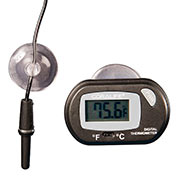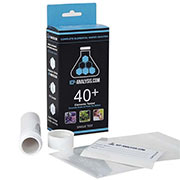
For about $100, you can create the perfect saltwater mixing container to have available for emergency water replacements, as well as your regular water changes. Always use purified water when mixing saltwater, either by purchasing distilled water or by producing it with an RO/DI filter.
What you need:
What you do:
- Rinse the plastic trash container with tap water, no detergents, and place it next to your aquarium. Fill the container with the amount of water you will need (ideally purified RO/DI water).
- Measure and record water temperature and specific gravity of your aquarium.
- Place the thermometer in the mixing container. Position the powerhead and heater near the bottom of the mixing container to allow the salt to dissolve quicker. Be sure to set the heater to match the water temperature of your aquarium.
- Divide the total amount of required salt into three equal parts. Slowly add the salt, a third at a time, making sure it dissolves completely before adding more. When all the salt is completely dissolved, measure the specific gravity with a hydrometer or refractometer.
- Adjust to achieve desired specific gravity; add more salt if too low and more water if too high.
- Run the powerhead for several hours to thoroughly aerate the newly prepared saltwater. Ideally, the salt mix should be prepared at least 24-hours in advance to achieve proper oxygen/carbon dioxide equilibrium.
Target Specific Gravity Ranges:
1.020 to 1.024 for fish only systems;
1.023 to 1.025 for reef systems.
Target Temperature Ranges:
72-80°F for fish only; 75-78°F for reefs. |
|
Once properly mixed, tested and oxygenated, the saltwater is ready to use. Be sure to use a lid when storing surplus saltwater to prevent contamination or evaporation.
Crucial Testing
Refractometers measure salt levels in water very accurately even in low salt situations and compensate for temperature. Simply lift the plastic lid from the angular end, place a drop of water on the surface, and close the lid. Look through the viewing lens (round end) as if you're looking through a telescope. The line where the blue and white areas meet is your salinity or specific gravity, depending on which scale you use. Add salt if too low, water if too high.
PRODUCTS WE RECOMMEND

Pumps & Powerheads |

Temperature Control |

Salt, Conditioners & Additives |

Testing |
|